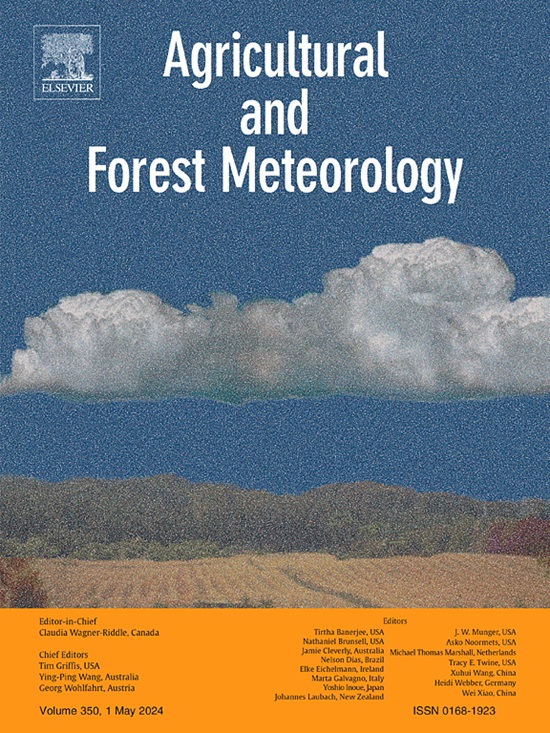中国冬油菜向北扩展的可行性分析
IF 5.6
1区 农林科学
Q1 AGRONOMY
引用次数: 0
摘要
中国西北地区海拔高,地形复杂,冬季寒冷,生态系统多样,油菜种植历史悠久,具有丰富的耐寒油菜种质资源。利用这些种质资源,过去 30 年间培育出了一批超耐寒油菜栽培品种,带动了中国冬油菜生产的大规模北扩。基于 19 年的田间试验数据,本研究旨在评估在超耐寒油菜品种问世之前,在中国北方传统上没有种植过冬油菜的地区种植冬油菜的可行性。分析了主要气候因素对越冬率和产量的影响。通过边界线分析,确定了不同栽培品种的适宜种植区域。超耐寒栽培品种在寒冷环境中表现出了超强的适应性,在冬季极端气温低至-42.35 °C的条件下,其越冬率超过70%。适宜性分析表明,中国北方多达 53.4 万平方公里的农田适合扩大冬油菜种植,冬油菜产量可能在 561 万吨至 1234 万吨之间。扩大种植面积可使国内油籽加工总量增加约 30%,显著提高中国植物油生产的自给率。我们的数据表明,这些新的超耐寒油菜栽培品种使中国北方的冬油菜生产具有可行性、盈利性、环境效益和经济重要性。本文章由计算机程序翻译,如有差异,请以英文原文为准。


Feasibility analysis of expanding winter rapeseed northwards in China
With high elevations, complex topographies, cold winter, diverse ecosystems, and a long history of oilseed Brassica rapa cultivation, Northwest China is rich in winter-hardy B. rapa germplasms. Using these germplasms, a number of ultra-winter-hardy rapeseed cultivars were developed in past three decades, leading to a large-scale northward expansion of winter rapeseed production in China. Based on 19 years of field trial data, this study was to assess the feasibility of growing winter rapeseed in the areas of northern China where conventionally no winter rapeseed had grown prior to availability of the ultra-winter-hardy B. rapa cultivars. The impacts of the major climate factors on overwintering rates and yields were analyzed. Using the boundary line analysis, the suitable growing regions for different cultivars were defined. The ultra winter-hardy cultivars displayed exceptional adaptability in frigid environments, with overwintering rates exceeding 70 % under conditions of extreme winter temperatures as low as -42.35 °C. Suitability analyses indicate that up to 534,000 km² of farmland in northern China are suitable for expanding winter rapeseed cultivation, potentially yielding between 5.61 and 12.34 million tons of winter rapeseed. This expansion could result in an approximately 30 % increase in the total domestic oilseed processing volume, significantly enhancing China's self-sufficiency in vegetable oil production. Our data suggest that these new ultra-winter-hardy rapeseed cultivars have made winter rapeseed production feasible, profitable, environmentally beneficial, and economically important in northern China.
求助全文
通过发布文献求助,成功后即可免费获取论文全文。
去求助
来源期刊
CiteScore
10.30
自引率
9.70%
发文量
415
审稿时长
69 days
期刊介绍:
Agricultural and Forest Meteorology is an international journal for the publication of original articles and reviews on the inter-relationship between meteorology, agriculture, forestry, and natural ecosystems. Emphasis is on basic and applied scientific research relevant to practical problems in the field of plant and soil sciences, ecology and biogeochemistry as affected by weather as well as climate variability and change. Theoretical models should be tested against experimental data. Articles must appeal to an international audience. Special issues devoted to single topics are also published.
Typical topics include canopy micrometeorology (e.g. canopy radiation transfer, turbulence near the ground, evapotranspiration, energy balance, fluxes of trace gases), micrometeorological instrumentation (e.g., sensors for trace gases, flux measurement instruments, radiation measurement techniques), aerobiology (e.g. the dispersion of pollen, spores, insects and pesticides), biometeorology (e.g. the effect of weather and climate on plant distribution, crop yield, water-use efficiency, and plant phenology), forest-fire/weather interactions, and feedbacks from vegetation to weather and the climate system.

 求助内容:
求助内容: 应助结果提醒方式:
应助结果提醒方式:


